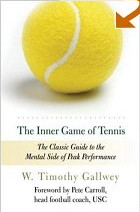April 3, 2003 Article Latest Between The Lines Article Between The Lines Archives:
Tennis Server
|

 |
Every four years during the Olympic Games, people everywhere follow the count of gold, silver, and bronze medals won by athletes of the different nations. The medal tally appears daily in the world press, adding an interesting dimension to the grand gathering. A comparable tally is possible in the realm of pro tennis, as every top pro specifies a tennis nationality--a kind of professional identity that typically remains unchanged when the player changes residence or even citizenship. Thus as a given Slam tournament unfolds, a count of matches won by players of the different nations can be maintained. In past versions of this column, we have indeed made tallies of such unofficial competition. Every main-draw match, whether singles or doubles, is weighted the same--a gesture toward simplicity. The emerging tally is especially interesting during the early rounds, when most of the matches take place. Offered here is a further design--one that takes such results and merges them with Davis Cup and other team-event outcomes. The product is a mythical year-end leader among the tennis nations. As will be noted, the objectives in designing our scheme remain simplicity and balance. Year 2003 In Men's Tennis Each new tennis year begins with Hopman Cup, an interesting two-person singles and mixed-doubles team event held in Perth, Australia. This year the winner was the U.S. team, consisting of James Blake and Serena Williams. For Blake's role we award one National Team Point (NTP) to the American men's team. (U.S. also earns one NTP in the women's team competition, discussed later.) The runner-up team was Australia (Hewitt and Molik). At the Australian Open in late January, won by Agassi, in singles the American males won 19 main-draw matches, just one more than Spain's men. But in doubles U.S. and Australia both strongly outscored Spain, thus giving the U.S. the overall lead in total matches won and giving Australia second place. Three more NTP thus go to the U.S., one to Australia. Davis Cup play began in early February. In World Group action, the American men faltered badly, eroding some of their early-year glory. Without Agassi and Roddick, and unable to cope with the superb serving of Ivan Ljubicic, the U.S. team lost to Croatia. Meanwhile the five Cup winners of the last five years--Russia, France, Spain, Australia, and Sweden--all won their first-round encounters. Noteworthy was Bjorkman's five-set win over Kuerten, which gave Sweden an unexpected victory over Brazil. Roger Federer's two singles wins sparked Switzerland's victory over host Netherlands, while Argentina on home clay swept Germany lacking Haas. Each first-round winning nation earns two NTP in our model, toward an eventual total of 16 NTP for whichever nation finally captures the Cup. With the month of March came the Masters Series tournaments in California and Florida. Agassi did not play at Indian Wells, won by Hewitt, but five American men reached the final eight in singles and the Bryans reached the final round in doubles, thus giving the U.S. a strong lead in total matches won. We therefore add one NTP to the U.S. tally. Australia and Spain tied for second. Two weeks later at Key Biscayne, the Americans again triumphed, thanks to broad strength in the early rounds of singles and doubles. Spain was a strong second, placing two stars in the semis. Agassi won the singles, in turn defeating Costa and Moya. To improve our system's power of definition we also award one-half NTP for third place in Slams and for second place in Masters events and Hopman Cup. Spain and Australia benefit in the current count. Thus the current tally in NTP looks like this:
USA, 6 The four winning nations in the next round of Davis Cup play (in early April) will each earn another three NTP, tightening our standings and probably pushing the U.S. down to third place. Spain and Argentina should be winners on home clay against Croatia and Russia, respectively. French depth should narrowly prevail over Switzerland behind Federer on medium-speed indoor courts in Toulouse, while the Australians, who will offer their best line-up, seem superior to host Sweden. The European spring season will then follow, bringing three Masters Series tournaments, World Team Cup, and Roland Garros, all on clay. At Garros last year, Spain's men won the most matches and Argentina was second, so both nations seem likely to rise in our NTP standings. Farther ahead lie Wimbledon, the hard-court season in North America, the fall events in Europe, and the late Davis Cup showdowns. Note that our practice of simply counting match wins in Slam and Masters tournaments favors those nations whose strength is in extreme depth over those nations having just a few warriors but ones close to the very top. Meanwhile our Davis Cup emphasis somewhat balances this effect, and we provide further balance by awarding graduated NTP to the year-end Top Eight players in singles and Top Four pairs in doubles. The current degree of parity in men's tennis, where a half-dozen nations are capable of challenging the Americans in our tally, seems healthy and worthy of note. Year 2003 In Women's Tennis The strength of the top American women--the Williams sisters, Capriati, Davenport, and Seles--together with considerable further U.S. depth, means that no single national team can hope to challenge the current American supremacy in women's tennis. The Americans have swept almost everything so far in 2003. Serena scored the Hopman Cup triumph, while the Williams sisters both reached the singles final and together won the doubles at Australian Open. At Melbourne Park American women won 28 of the 127 main-draw singles matches--more than twice the total of any other nation--and did even better in the doubles. At the Pan-Pacific--the first of the year's Tier Ones--the Americans captured all four semi-finalist places in singles. Then at Indian Wells, the Americans placed three in the singles final eight, Lindsay Davenport was runner-up to Belgian player Clijsters, and the American pair Davenport-Raymond won the doubles. At Key Biscayne, three American women reached the semis, and Serena.won the tournament. With Venus and Serena scheduled to play for the U.S. in the first round, American prospects for winning Fed Cup and, with it, 16 NTP seem favorable. Contenders for second place in our NTP standings include the young Russian women, who are making an upward surge, and Belgium, which offers two superstars both in the world's top five. The apparent retirement of the Swiss Miss, Hingis, seriously weakens competition across the nations. I hope readers will offer comments to me using this form on the thoughts offered here--the notion of tracking match wins by nation during tournaments and the concept of linking the events by awarding NTP. Footnote: Our scheme awards a total of 110.5 NTP in men's competition, as summarized in this footnote. Women's NTP are similarly awarded, except there is no counterpart to World Team Cup.
--Ray Bowers
1995 - May 1998 | August 1998 - 2003 | 2004 - 2015
This column is copyrighted by Ray Bowers, all rights reserved.
Following interesting military and civilian careers, Ray became a regular
competitor in the senior divisions, reaching official rank of #1 in the 75
singles in the Mid-Atlantic Section for 2002. He was boys' tennis coach for four
years at Thomas Jefferson High School for Science and Technology, Virginia, where
the team three times reached the state Final Four. He was named Washington
Post All-Metropolitan Coach of the Year in 2003. He is now researching a history
of the early pro tennis wars, working mainly at U.S. Library of Congress. A
tentative chapter, which appeared on Tennis Server, won a second-place award
from U.S. Tennis Writers Association.
Questions and comments about these columns can be directed to Ray by using this form.
|



October 2022 Tennis Anyone: Patterns in Doubles by John Mills. September 2022 Tennis Anyone: Short Court by John Mills. |
 You will join 13,000 other subscribers in receiving news of updates to the Tennis Server along with monthly tennis tips from tennis pro Tom Veneziano.
You will join 13,000 other subscribers in receiving news of updates to the Tennis Server along with monthly tennis tips from tennis pro Tom Veneziano. 